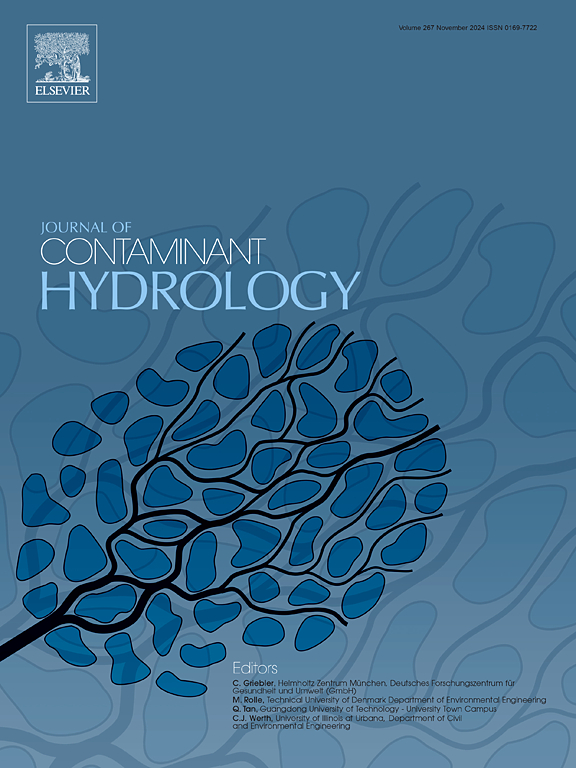Study on the service performance of heterogeneous cutoff walls and three-dimensional transport of pollutants considering compression effect
IF 3.5
3区 环境科学与生态学
Q2 ENVIRONMENTAL SCIENCES
引用次数: 0
Abstract
Vertical cutoff walls are widely used as an effective in-situ remediation technology for non-point source contaminated sites. In this study, considering the arch effect and lateral extrusion effect of the wall, a method for calculating the heterogeneous parameters of the cutoff wall is proposed based on the horizontal spring model. A three-dimensional model of unsteady pollutant transport in the unsaturated zone (internal aquifer-cutoff wall-external aquifer) is developed, incorporating the coupled convection-diffusion-adsorption-degradation processes. The research demonstrates that the shallow part of the wall is prone to forming a dominant migration channel. As the position of the peak concentration of the pollution source and the distribution range () of high-concentration pollutants increase, both the breakdown time tb and the depth hb of the breakdown point increase. When the buried depth hb of the breakdown point is small (with and also small), tb is less affected by the wall effective angle of internal friction and wall shear strength reduction factor Rr. Conversely, as the buried depth hb increases (with larger values of and ), the influence of and Rr on tb becomes more significant. Finally, a design method for determining the depth hr of the shallow enhanced cutoff wall under different pollutant concentration distributions is proposed. This study offers valuable insights for evaluating cutoff wall performance, optimizing backfill mix ratios, and improving wall structure design.
考虑压缩效应的非均质截流墙使用性能及污染物三维运移研究
垂直截流墙作为一种有效的非点源污染场地原位修复技术被广泛应用。本文考虑了墙体的拱效应和侧向挤压效应,提出了一种基于水平弹簧模型的防渗墙非均质参数计算方法。建立了含对流-扩散-吸附-降解耦合过程的非饱和带(含水层内-截流墙-外含水层)非定常污染物运移的三维模型。研究表明,岩壁浅部容易形成优势运移通道。随着污染源峰浓度位置μ1和高浓度污染物分布范围(σ)的增加,击穿时间tb和击穿点深度hb均增加。当击穿点埋深hb较小时(μ1和σ也较小时),tb受墙体有效内摩擦角φcw和墙体抗剪强度折减系数Rr的影响较小。相反,随着埋深hb的增加(μ1和σ值越大),φcw和Rr对tb的影响越显著。最后,提出了一种确定不同污染物浓度分布下浅层强化防渗墙深度hr的设计方法。该研究为评价防渗墙性能、优化回填配合比、改进防渗墙结构设计提供了有价值的见解。
本文章由计算机程序翻译,如有差异,请以英文原文为准。
求助全文
约1分钟内获得全文
求助全文
来源期刊

Journal of contaminant hydrology
环境科学-地球科学综合
CiteScore
6.80
自引率
2.80%
发文量
129
审稿时长
68 days
期刊介绍:
The Journal of Contaminant Hydrology is an international journal publishing scientific articles pertaining to the contamination of subsurface water resources. Emphasis is placed on investigations of the physical, chemical, and biological processes influencing the behavior and fate of organic and inorganic contaminants in the unsaturated (vadose) and saturated (groundwater) zones, as well as at groundwater-surface water interfaces. The ecological impacts of contaminants transported both from and to aquifers are of interest. Articles on contamination of surface water only, without a link to groundwater, are out of the scope. Broad latitude is allowed in identifying contaminants of interest, and include legacy and emerging pollutants, nutrients, nanoparticles, pathogenic microorganisms (e.g., bacteria, viruses, protozoa), microplastics, and various constituents associated with energy production (e.g., methane, carbon dioxide, hydrogen sulfide).
The journal''s scope embraces a wide range of topics including: experimental investigations of contaminant sorption, diffusion, transformation, volatilization and transport in the surface and subsurface; characterization of soil and aquifer properties only as they influence contaminant behavior; development and testing of mathematical models of contaminant behaviour; innovative techniques for restoration of contaminated sites; development of new tools or techniques for monitoring the extent of soil and groundwater contamination; transformation of contaminants in the hyporheic zone; effects of contaminants traversing the hyporheic zone on surface water and groundwater ecosystems; subsurface carbon sequestration and/or turnover; and migration of fluids associated with energy production into groundwater.
 求助内容:
求助内容: 应助结果提醒方式:
应助结果提醒方式:


